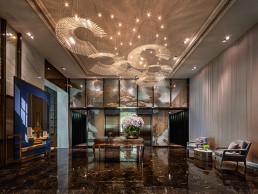
Rosewood Hotel, Bangkok
Interior designer Celia Chu worked alongside lighting design studio UnoLai Design to bring the new Rosewood Hotel in Bangkok to life. Making use of one-off, sculptural lighting pieces to ensure each space within the hotel is full of meaning and communicates with its clients.
Rosewood Bangkok is a 30-storey, visually stunning architectural marvel. Its form is inspired by the ‘wai’ – a famous Thai gesture of greeting – while the modern silhouette is a creative expression of the Thai spirit. Rich Thai culture is also emphasised by interior design elements and the exquisite water features within the hotel that are a tribute to Bangkok, a city built on water.
Destined to establish a new design icon for the Kingdom’s capital and the world stage, Rosewood Bangkok’s contemporary residential styling allows each guest to be welcomed and treated with personalised attention just as if they were entering their own manor home – a true tribute to the Rosewood brand’s philosophy.
The hotel offers an intimate, secure and private ambience in the heart of Bangkok and features unique, specialty suites and houses with private pools and terraces, reinforcing an exclusive residential feel. The sense of staying in a fine private home is complemented by warm hospitality, delivered by a team dedicated to creating lasting memories for guests. Located in Bangkok’s central business embassy and upscale retail district, the property is a new gateway for Rosewood in Southeast Asia.
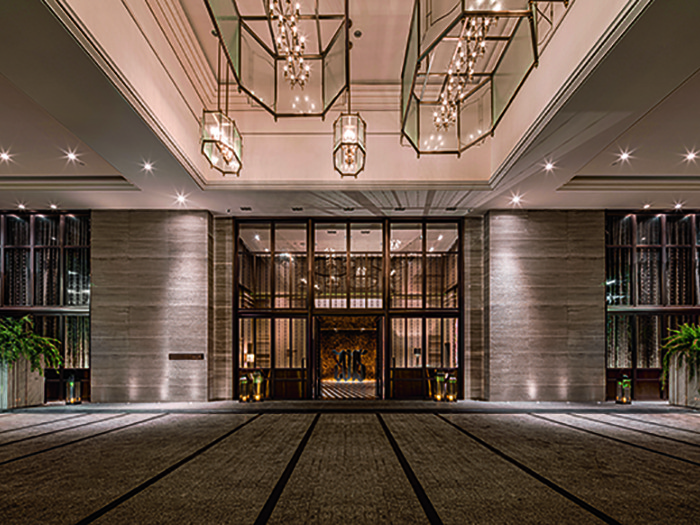
Celia Chu Design, together with lighting designers UnoLai Design, worked to bring the Rosewood interiors to life, making sure strong decorative lighting played a key role at every stage of the project.
“To me (when working on a hotel project), it is important to first understand what kind of a story you want to tell and how you want the guest to feel,” Celia Chu tells darc. “Each space within Rosewood Bangkok is full of meaning, which we believe creates strong connections with the guests.
“I like to work with high-end hotel chains that give us the freedom and space to do our job – to design. We do have to keep in mind that each hotel has its own DNA and standards, but we are still able to present the story we are looking to tell. We wanted to create a hotel that becomes a home from home for both local clients and international travellers. The way international visitors view Thai culture and what they expect to see from the design approach of the hotel is completely different to local people.”
For Chu, decorative lighting is always a highlight of any space she works on, considering it the ‘lead performance’. “Decorative lighting expresses each chapter of the story we are telling and becomes the spotlight that shows off the design concept,” she says.
“We like to make sure the entire space works fluidly and design the lighting layer by layer. As early as the pick-up / drop-off point we created a homely and welcoming vibe, which is the most important concept of the design.”
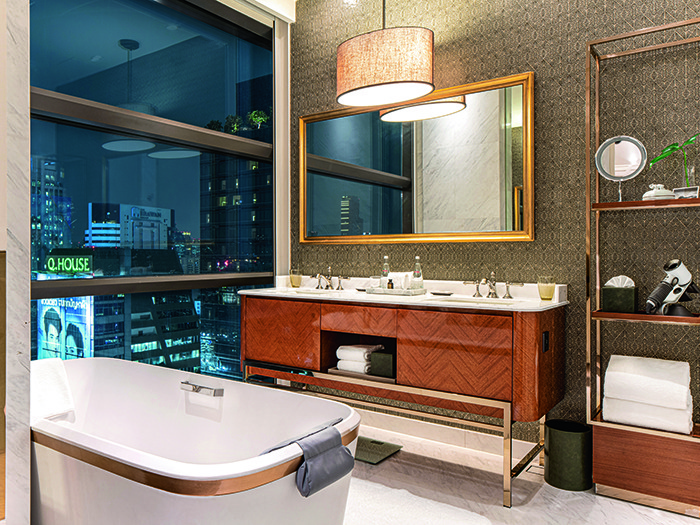
“For the general lighting design of the Rosewood hotel we used warm coloured lights to reinforce this residential impression for the travellers, rather than bright, dazzling lights,” adds Uno Lai, founder of UnoLai Design & Associates. “We carried this throughout the project, consistently using the same lighting tones in the lobby and lounge, which is more comforting and provides an even warmer touch for guests. The lighting – together with the art collections – in the hallway, heading towards the guestrooms, is even more subdued and intimate than from where guests first enter the hotel.
“In the guest rooms themselves, instead of using many downlights, we utilised more decorative lighting to balance the atmosphere of private, comfortable surroundings, By using floor lamps, table lamps and wall lamps, as well as reading lamps with adjustable dimming controls, we hoped to bring a sense of calm to the rooms. By doing so, the lighting also fits the needs of different scene settings from day to night, from holidaymaker to businessman.”
Elsewhere in the hotel, the public spaces continue with this ‘warm and cozy’ lighting feel – with the spa in particular creating a wonderland for the guests to enjoy and truly relax. In the restaurant and bar, the lighting can also be changed in order to suit the mood depending on the time of day and related events taking place in the space.
“We have used a couple of feature lights within this project,” continues Chu. “Such as the bespoke crystal light fixture in the Pavilion function rooms and residential ballroom space, inspired by traditional Thai dancing. The shape of the piece is inspired by the spinning dancing gesture, while the composition of crystal pieces and the decorative metal sheet shows the harmonious balance between female and male or ying and yang.
“Another example is the lighting fixture in the Sky lobby, which is inspired by the traditional fan used to battle against the hot weather in Bangkok. For both of these bespoke fixtures we worked together with Lasvit.
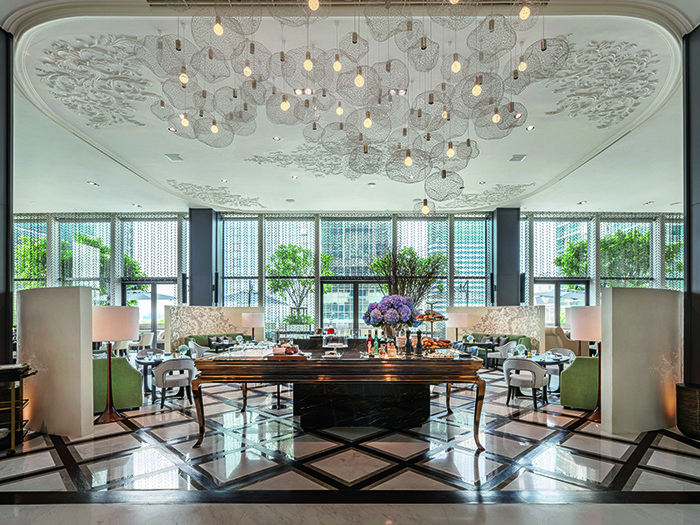
“We also worked with local Thai lighting firm Ango on a bespoke feature, which can be seen as you enter the Lakron all-day dining European brasserie – a western dining venue that offers stunning views and elegant cuisine. The customised Ango jewellery series of lighting was uniquely created for the Rosewood project.”
“We have been delighted to receive so much positive feedback from the hotel owners and guests on the interior design at Rosewood,” continues Chu. “In all of our designs we carefully consider both decorative and architectural lighting – the two cannot be separated. Often in projects you will find the lighting designer only working on the architectural lighting elements, whereas I don’t believe this is a good idea as there is a balancing act between the two, which makes a big difference to the final result.”
“For some, decorative lighting feels like a small part of an interior design,” adds Lai, “but it actually plays a big role. Contrast and balance are key to working with architectural lighting. We direct different expressions between decorative and architectural lighting during the day / night and in each space. There are two major ideas behind the lighting design at Rosewood; first of all we arranged more accessible lighting in guest rooms that can affect guests’ emotions and perceptions or can even be controlled by themselves – such as the table lamps, floor lamps and pendants.
“Secondly, there are the collaborations with Lasvit and Ango for the bespoke lighting features – creating a lavish, modern and luxurious atmosphere. With these two ideas the lighting designs show hospitality with luxurious atmospheres at the Rosewood.
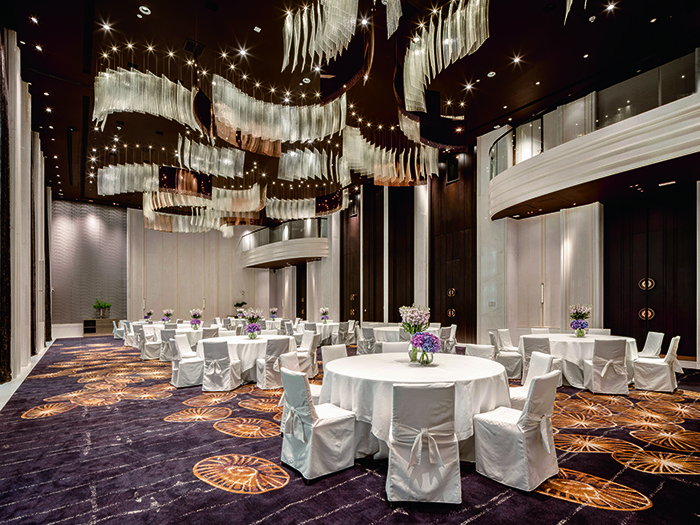
“For a commercial space we used quite a large amount of pendants and chandelier-like pendants at Rosewood. It was a challenge for us but we managed to avoid any additional construction requirements in this project.”
Reflecting on the project, for Chu – while each and every project is unique and designed from the heart, for this particular project the most special part was the fact that the owners of Rosewood are female.
As such, she “wanted to create a hotel with the sense of a ‘female’s perspective’ – developing a sense of beauty and elegance and I feel we achieved this, without the hotel being too feminine. This project has innumerable good memories for me. I have already taken aspects of this journey forward on new hotel projects underway in Taiwan.”
And on working with Unolai Design on this project, Chu tells darc: “They have been our lighting partner for thirteen years – we share a friendship, vision and passion for design. I always believe each speciality has its own skills – there’s no way for interior designers to control the mood of a space without a lighting designer. I believe, it is only by working together, that we can make the most accurate and most profound design result for our clients.”



